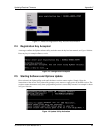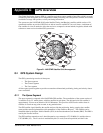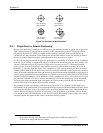
72 SUPERSTAR II User Manual Rev 3
Appendix G GPS Overview
Figure 25: Illustration of GPS Signal Multipath
G.4.1 Why Does Multipath Occur?
When the GPS signal is emitted from the satellite antenna, the RF signal propagates away from the antenna in
many directions. Because the RF signal is emitted in many directions simultaneously and is traveling different
paths, these signals encounter various and differing natural and man-made objects along the various
propagation routes. Whenever a change in medium is encountered, the signal is either absorbed, attenuated,
refracted, or reflected.
Refraction and reflection cause the signals to change direction of propagation. This change in path directions
often results in a convergence of the direct path signal with one or more of the reflected signals. When the
receiving antenna is the point of convergence for these multipath signals, the consequences are generally not
favorable.
Whenever the signal is refracted, some signal polarity shifting takes place. When full reflection occurs, full
polarity reversal results in the propagating wave. The consequences of signal polarity shifting and reversal at
the receiving antenna vary from minor to significant. As well, refracted and reflected signals generally sustain
some degree of signal amplitude attenuation.
It is generally understood that, in multipath conditions, both the direct and reflected signals are present at the
antenna and the multipath signals are lower in amplitude than the direct signal. However, in some situations,
the direct signal may be obstructed or greatly attenuated to a level well below that of the received multipath
signal. Obstruction of direct path signals is very common in city environments where many tall buildings block
the line of sight to the satellites. As buildings generally contain an abundance of metallic materials, GPS signal
reflections are abundant (if not overwhelming) in these settings. Obstructions of direct path signals can occur in
wilderness settings as well. If the GPS receiver is in a valley with nearby hills, mountains and heavy vegetation,
signal obstruction and attenuation are also very common.
G.4.2 Consequences of Multipath Reception
Because GPS is a radio ranging and positioning system, it is imperative that ground station signal reception
from each satellite be of direct line of sight. This is critical to the accuracy of the ranging measurements.
Obviously, anything other than direct line of sight reception will skew and bias the range measurements and
thus the positioning triangulation (or more correctly, trilateration). Unfortunately, multipath is almost always


















